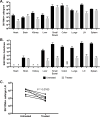Defining total-body AIDS-virus burden with implications for curative strategies
- PMID: 28967921
- PMCID: PMC5831193
- DOI: 10.1038/nm.4411
Defining total-body AIDS-virus burden with implications for curative strategies
Abstract
In the quest for a functional cure or the eradication of HIV infection, it is necessary to know the sizes of the reservoirs from which infection rebounds after treatment interruption. Thus, we quantified SIV and HIV tissue burdens in tissues of infected nonhuman primates and lymphoid tissue (LT) biopsies from infected humans. Before antiretroviral therapy (ART), LTs contained >98% of the SIV RNA+ and DNA+ cells. With ART, the numbers of virus (v) RNA+ cells substantially decreased but remained detectable, and their persistence was associated with relatively lower drug concentrations in LT than in peripheral blood. Prolonged ART also decreased the levels of SIV- and HIV-DNA+ cells, but the estimated size of the residual tissue burden of 108 vDNA+ cells potentially containing replication-competent proviruses, along with evidence of continuing virus production in LT despite ART, indicated two important sources for rebound following treatment interruption. The large sizes of these tissue reservoirs underscore challenges in developing 'HIV cure' strategies targeting multiple sources of virus production.
Conflict of interest statement
There is NO Competing Interest.
Figures






References
-
- Embretson J, et al. Analysis of human immunodeficiency virus-infected tissues by amplification and in situ hybridization reveals latent and permissive infections at single-cell resolution. Proceedings of the National Academy of Sciences of the United States of America. 1993;90:357–361. - PMC - PubMed
-
- Embretson J, et al. Massive covert infection of helper T lymphocytes and macrophages by HIV during the incubation period of AIDS [see comments] Nature. 1993;362:359–362. - PubMed
-
- Faust RA, et al. Outpatient biopsies of the palatine tonsil: access to lymphoid tissue for assessment of human immunodeficiency virus RNA titers. Otolaryngology Head & Neck Surgery. 1996;114:593–598. - PubMed
MeSH terms
Substances
Grants and funding
LinkOut - more resources
Full Text Sources
Other Literature Sources
Medical

